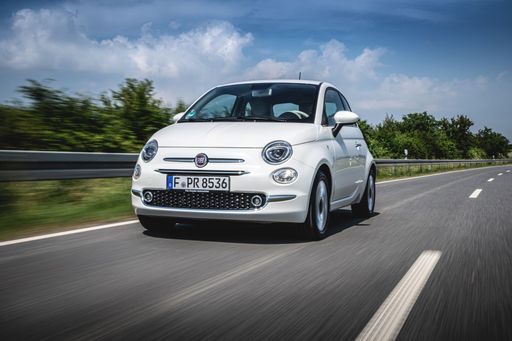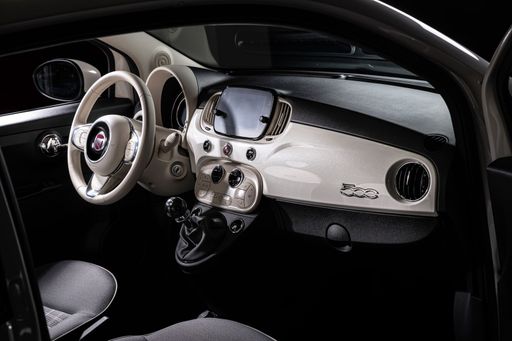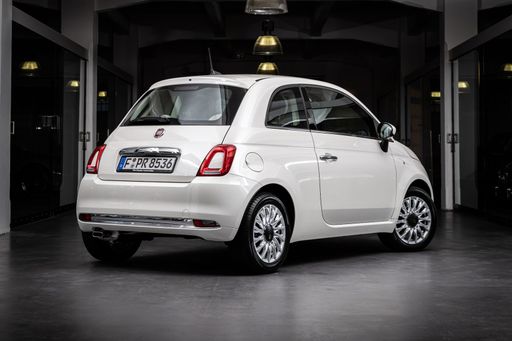Fiat 500 VS VW Transporter Transporter – Specs, Efficiency & Price Comparison
Which model is the better choice – the Fiat 500 or the VW Transporter Transporter? We compare performance (118 HP vs 286 HP), boot capacity (185 L vs ), efficiency (13 kWh vs 21.90 kWh7.10 L), and of course, the price (25300 £ vs 37500 £).
Find out now which car fits your needs better!
The Fiat 500 (Hatchback) is powered by a Electric engine and comes with a Automatic transmission. In comparison, the VW Transporter Transporter (Cargo Van) features a Diesel, Plugin Hybrid or Electric engine and a Manuel or Automatic gearbox.
When it comes to boot capacity, the Fiat 500 offers 185 L, while the VW Transporter Transporter provides – depending on what matters most to you. If you’re looking for more power, you’ll need to decide whether the 118 HP of the Fiat 500 or the 286 HP of the VW Transporter Transporter suits your needs better.
There are also differences in efficiency: 13 kWh vs 21.90 kWh7.10 L. In terms of price, the Fiat 500 starts at 25300 £, while the VW Transporter Transporter is available from 37500 £.
Compare all the key specs now and find out which model fits your lifestyle best!
Fiat 500
The Fiat 500 is a compact and stylish city car that has captured the hearts of urban drivers with its charming retro design. Its nimble handling and efficient engine make navigating tight city streets a breeze, while its cosy interior offers a surprising amount of comfort and modern technology. The car's iconic silhouette and vibrant colour options ensure it stands out, offering a unique blend of timeless appeal and contemporary flair.
details @ media.stellantis.com
@ media.stellantis.com
 @ media.stellantis.com
@ media.stellantis.com
 @ media.stellantis.com
@ media.stellantis.com
VW Transporter Transporter
The VW Transporter, a versatile favourite among commercial vehicles, combines practicality with modern design. Its spacious interior offers ample room for both passengers and cargo, making it a reliable choice for businesses and families alike. The vehicle's strong build and advanced technology ensure a smooth and efficient driving experience in various conditions.
details

|
|
|
|
|
Costs and Consumption |
|
|---|---|
|
Price
25300 - 35600 £
|
Price
37500 - 60800 £
|
|
Consumption L/100km
-
|
Consumption L/100km
7.1 - 8.4 L
|
|
Consumption kWh/100km
13 - 14.7 kWh
|
Consumption kWh/100km
21.9 - 24.4 kWh
|
|
Electric Range
190 - 321 km
|
Electric Range
56 - 331 km
|
|
Battery Capacity
21.3 - 37.3 kWh
|
Battery Capacity
11.8 - 63.8 kWh
|
|
co2
0 g/km
|
co2
0 - 220 g/km
|
|
Fuel tank capacity
-
|
Fuel tank capacity
55 L
|
Dimensions and Body |
|
|---|---|
|
Body Type
Hatchback
|
Body Type
Cargo Van
|
|
Seats
4
|
Seats
2 - 5
|
|
Doors
3 - 4
|
Doors
4 - 5
|
|
Curb weight
1330 - 1475 kg
|
Curb weight
1872 - 2462 kg
|
|
Trunk capacity
185 L
|
Trunk capacity
-
|
|
Length
3632 mm
|
Length
5050 - 5450 mm
|
|
Width
1683 mm
|
Width
2032 mm
|
|
Height
1527 mm
|
Height
1966 - 1985 mm
|
|
Payload
250 - 305 kg
|
Payload
755 - 1259 kg
|
Engine and Performance |
|
|---|---|
|
Engine Type
Electric
|
Engine Type
Diesel, Plugin Hybrid, Electric
|
|
Transmission
Automatic
|
Transmission
Manuel, Automatic
|
|
Transmission Detail
-
|
Transmission Detail
Manual Gearbox, Automatic Gearbox
|
|
Drive Type
Front-Wheel Drive
|
Drive Type
Front-Wheel Drive, All-Wheel Drive, Rear-Wheel Drive
|
|
Power HP
95 - 118 HP
|
Power HP
110 - 286 HP
|
|
Acceleration 0-100km/h
9 - 9.5 s
|
Acceleration 0-100km/h
7.4 - 16.9 s
|
|
Max Speed
135 - 150 km/h
|
Max Speed
112 - 150 km/h
|
|
Torque
220 Nm
|
Torque
310 - 415 Nm
|
|
Number of Cylinders
-
|
Number of Cylinders
4
|
|
Power kW
70 - 87 kW
|
Power kW
81 - 210 kW
|
|
Engine capacity
-
|
Engine capacity
1996 - 2488 cm3
|
General |
|
|---|---|
|
Model Year
2023 - 2025
|
Model Year
2025
|
|
CO2 Efficiency Class
A
|
CO2 Efficiency Class
G, A
|
|
Brand
Fiat
|
Brand
VW
|
Fiat 500
The Timeless Charm: Introducing the Fiat 500
The Fiat 500 has long been a symbol of Italian style and urban practicality. As we navigate a new era in automotive history, the Fiat 500 continues to adapt and remains a much-loved vehicle worldwide. Let’s delve into the latest technical details and innovations that make this car a modern classic.
Electric Heartbeat: The Engines and Performance
The latest Fiat 500 models are powered entirely by electricity, showcasing a commitment to sustainable mobility without sacrificing performance. Under the stylish bonnet lies a choice between two power outputs, starting from a lively 70 kW (95 PS) to an energetic 87 kW (118 PS). This range of electric motors ensures that whether you’re navigating narrow city streets or cruising along open roads, the Fiat 500 delivers engaging performance with zero emissions.
Efficiency Meets Innovation: Energy Consumption and Range
Efficiency is at the forefront of the Fiat 500’s design. With energy consumption figures as low as 13 to 14.7 kWh/100km, the car balances power and performance efficiently. Electric range varies across the models, from 190 km for those designed for short urban commutes to an impressive 321 km for longer journeys. The innovative lithium-ion battery options—spanning 23.8 kWh to 42 kWh—are neatly integrated to maintain the car’s compact dimensions.
Technological Marvel: Smart Features and Design
The Fiat 500 is adorned with advanced features that enhance convenience and safety. It comes with an intuitive infotainment system that includes smartphone connectivity, navigation, and various driver assistance technologies, ensuring a seamless driving experience. The “La Prima” equipment line offers premium materials and a luxurious feel inside the cabin, making every journey comfortable and enjoyable.
Urban Flexibility: Compact Dimensions and Practicality
Designed for urban environments, the Fiat 500’s dimensions make it ideally suited for city dwellers. With a length of 3632 mm, width of 1683 mm, and height of 1527 mm, it’s easy to navigate through traffic and park in tight spaces. Despite its compact size, the Fiat 500 provides a practical boot capacity of 185 litres, perfect for daily errands or a weekend getaway.
Commitment to the Environment: Sustainability Focus
The Fiat 500 exemplifies a dedication to eco-friendliness with its CO2 emissions at zero, earning it an A in CO2 efficiency class. By choosing this vehicle, drivers are contributing towards a future with reduced automotive pollution, supporting cleaner air and healthier urban living.
Conclusion: The Future of Urban Driving
The Fiat 500 perfectly blends timeless style with modern electric innovations, setting a precedent for future city cars. Whether you prioritise aesthetic design, sustainable driving, or a premium driving experience, the Fiat 500 is designed to exceed expectations and redefine urban transportation.
VW Transporter Transporter
Revolutionizing Utility: The VW Transporter T7
The latest iteration of the VW Transporter, known widely as the Transporter T7, marks a significant evolution in utility vehicle design and functionality. As a mainstay in the VW lineup, the Transporter T7 comes with a plethora of options, ensuring that it meets a variety of professional and personal needs.
Diverse Models to Fit Every Need
For 2025, the VW Transporter T7 is available in multiple configurations, ranging from efficient diesel engines to innovative hybrid systems. The conventional models are powered by a 2.0 TDI diesel engine, offering three power outputs: 110 HP, 150 HP, and a vigorous 204 HP. For those seeking a more sustainable option, the 2.5 eHybrid model provides a combined power output of 233 HP with an electric range of 56 km, thanks to its 11.8 kWh battery.
Innovative Technical Aspects
Underpinning the technical innovations of the Transporter T7 is VW's dedication to cutting-edge engineering. The diesel engines provide torque ranging from 310 Nm up to 390 Nm, ensuring robust performance across the lineup. Moreover, the T7 offers configurations with either manual or automatic gearboxes, catering to different driving preferences.
The availability of front-wheel drive and the 4MOTION all-wheel-drive system across the range enhances versatility, allowing the Transporter T7 to tackle various terrains with ease. With body lengths extending to 5450 mm and a payload capacity of up to 1259 kg, the Transporter T7 stands as a paragon of practicality for transporting goods or accommodating passengers.
Comfort and Design Revolution
Beyond performance, the VW Transporter T7 has been designed with driver comfort and ergonomic efficiency in mind. The cabins offer ample seating configurations, supporting both two-seat and five-seat layouts. The inclusion of modern conveniences elevates the driving experience, making long hauls more manageable and stress-free.
The exterior dimensions, with a width of 2032 mm and a height up to 1969 mm, marry the classic robust design with a contemporary touch, making the Transporter T7 a visual centerpiece in any fleet.
Economical and Environmental Impact
Economic efficiency is another critical aspect of the VW Transporter T7's design philosophy. With diesel fuel tank capacities between 55 and 63 liters, and an emphasis on improving mileage with each engine variant, operational costs are kept at a minimum. Additionally, the eHybrid model not only offers environmental benefits but also presents substantial savings on fuel through its electric range capability.
Conclusion: The Transporter T7 Legacy Continues
The VW Transporter T7 furthers the legacy of its predecessors by combining practicality, innovation, and eco-friendliness. Whether utilized for business in its cargo van capacity or adapted for personal use with seating comforts, the Transporter T7 is set to remain a critical player in the automotive sector, pushing the boundaries of what a multi-purpose van can achieve.
The prices and data displayed are estimates based on German list prices and may vary by country. This information is not legally binding.
